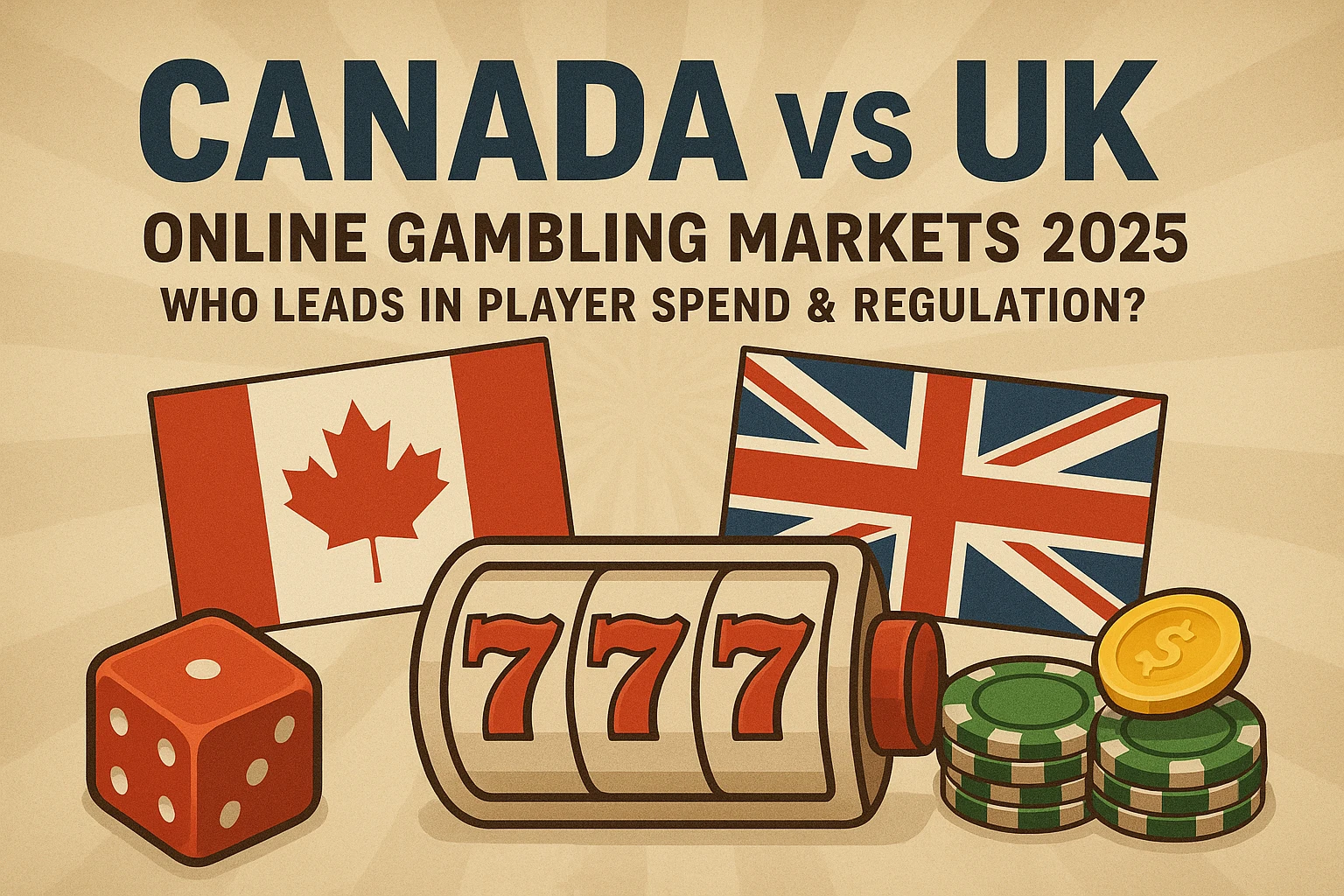
Canada vs UK Online Gambling Markets 2025: Who Leads in Player Spend & Regulation?
The online gambling world is a high-stakes arena, and in 2025, the Canada vs UK gambling market comparison reveals two powerhouses battling for dominance. Both nations boast thriving iGaming scenes, fueled by tech-savvy players, innovative platforms, and evolving regulations.
But who’s really leading the charge? Is it Canada, with its province-driven approach and soaring player engagement, or the UK, with its tightly regulated, centralized system?
This deep dive into the 2025 gambling revenue, player behaviors, and regulatory landscapes uncovers the trends, stats, and strategies shaping the UK iGaming market and Canada iGaming market.
From player spend to rulebooks, let’s explore how these markets stack up and what’s driving their growth.
Comparing Canada and the UK: Player Spending and Regulatory Approaches in 2025
The UK vs Canada gambling trends in 2025 hinge on distinct approaches to regulation and player spending patterns.
Canada’s decentralized, province-by-province system contrasts sharply with the UK’s unified, stringent framework, impacting how much players spend and how operators thrive.
Let’s break down the core differences in player spend Canada vs UK and their regulatory models.
To clearly illustrate the differences in player spending and regulatory approaches, the following table compares key aspects of the Canada and UK online gambling markets in 2025.
|
Aspect |
Canada |
UK |
| Market Size (2025) | C$16 billion total gambling revenue, with online platforms gaining traction. Offshore sites attract $4 billion annually. | £5.8 billion online Gross Gambling Yield (GGY), with £3.2 billion from online casinos and £1.9 billion from sports betting. |
| Player Spend | Average monthly spend: $6.75; 43% spend $1–$20, 14% spend $20–$100. 19.3 million active gamblers. | Higher per-player spend; 56% of adults gamble yearly, with 4.4 million monthly active online accounts. Slots GGY up 15% to £709 million in Q1 2025. |
| Regulatory Framework | Decentralized, province-based. Ontario’s AGCO enforces strict licensing; Alberta’s Bill 16 (2024) sets 2025 market. Varying oversight. | Centralized under UK Gambling Commission (UKGC). £5 slot stake limits, £150 deposit checks, opt-in marketing from May 2025. |
| Revenue Drivers | Slots (67,000 machines), lotteries (65% of gamblers), and growing sports betting. Mobile gambling at 60% of market. | Football betting, slots (23.9 billion spins in Q4 2024), horse racing. Online casino GGY: £3.2 billion annually. |
| Player Demographics | 30–50 years old, 56% men, 43% women. Middle-income groups spend more. Problem gambling: 2%. | Broad base; 70–80% bingo players are women (30–50), sports betting male-dominated. Problem gambling: 300,000. |
| Trends | Mobile gambling surge, VR slots, single-event sports betting (Bill C-218, 2021). Offshore sites compete. | AI personalization, AR/VR games, sports betting during events like Cheltenham Festival. Black-market visits up 522%. |
| Regulatory Challenges | Inconsistent provincial rules, offshore site oversight gaps. | High compliance costs, black-market growth due to strict rules. |
| Growth Projections | 10% growth rate, driven by new markets like Alberta and mobile platforms. | 7% GGY growth in Q1 2025; projected £15.3 billion total market by 2029. |
With these differences in mind, let’s explore how market size and revenue further distinguish the Canada iGaming market from the UK iGaming market.
I’ve spent decades analyzing the Canada iGaming market, and let me tell you, Ontario’s 2022 launch changed everything. With 19.3 million Canadians gambling and $16 billion in play, the province’s AGCO model is a blueprint for balancing player freedom with safety—something the UK’s rigid UKGC rules could learn from to ease operator strain.
— Hanna
Player Spending in 2025
Canada
The Canadian gambling market forecast for 2025 projects robust growth, with over 19.3 million active gamblers spending an estimated $16 billion CAD annually across local and offshore platforms. Ontario, a trailblazer since legalizing its iGaming market in April 2022, drives significant revenue, with 43% of Canadians spending $1–$20 monthly and 14% spending $20–$100. The average Canadian gambler spends $6.75 monthly, reflecting a broad but cautious engagement. Slots dominate, with over 67,000 machines nationwide, particularly in Ontario (23,750).
UK
The UK gambling market size is formidable, with online gross gambling yield (GGY) reaching £1.45 billion in Q1 2025, a 7% year-on-year increase. Online slots alone generated £709 million, up 15%, fueled by 4.4 million monthly active accounts. Sports betting, especially during events like the Cheltenham Festival, remains a key driver, with 35% of the population placing sports wagers annually. The UK’s higher per-player spend reflects deeper engagement, with 56% of adults gambling at least once yearly.
Regulatory Approaches
- Canada: Online gambling regulations Canada vary by province, creating a patchwork system. Ontario’s Alcohol and Gaming Commission of Ontario (AGCO) sets a high standard, enforcing strict licensing and responsible gambling measures, like self-exclusion tools. Alberta’s Bill 16, passed in 2024, paves the way for a regulated market by mid-2025. This fragmented approach fosters innovation but risks inconsistency, with some provinces lagging in oversight.
- UK: Online gambling regulations UK are centralized under the UK Gambling Commission (UKGC), enforcing the Gambling Act 2005 and 2023 White Paper reforms. Key 2025 measures include £5 slot stake limits (£2 for 18–24-year-olds), financial vulnerability checks at £150 monthly deposits, and opt-in marketing rules from May 2025. The UKGC’s crackdown on black-market sites, issuing 770 cease-and-desist notices, underscores its focus on player safety.
The iGaming regulations comparison highlights Canada’s flexibility versus the UK’s uniformity.
Canada’s model allows provinces to tailor rules, boosting local innovation but complicating national standards.
“When I look at the UK online casino market 2025, the £5.8 billion GGY is impressive, but those £5 slot stake limits hit hard. I’ve seen players frustrated by the UKGC’s tight grip, pushing some to risky black-market sites—Canada’s looser, province-based rules let players breathe, even if oversight’s patchy.”
The UK’s strict, consistent oversight ensures safety but may stifle operator growth, with some pulling back due to compliance costs.
Market Size and Revenue: A Head-to-Head Look
The iGaming revenue comparison between Canada and the UK in 2025 reveals distinct strengths. Canada’s market thrives on volume and diversity, while the UK’s leans on high engagement and regulatory stability.
Canada iGaming Market
Canada gambling statistics 2025 show a total gambling revenue exceeding C$16 billion in 2023, with online platforms gaining traction post-pandemic. Offshore sites attract $4 billion annually, reflecting Canada’s openness to global operators. Ontario’s iGaming market alone generated significant revenue since 2022, with projections for 2025 suggesting a 10% growth rate, driven by mobile gambling (60% of the sector).
UK iGaming Market
The UK online casino market 2025 is a juggernaut, with online GGY projected to hit £5.8 billion for the year, up from £5.4 billion in 2023. Online casinos contribute £3.2 billion, sports betting £1.9 billion, and slots a growing share. The UK’s 21% GGY growth from Q4 2023 to Q4 2024 signals resilience despite regulatory pressures. The UK gambling market analysis suggests a more mature, saturated market with higher per-capita spending, while Canada’s younger, fragmented market is catching up, fueled by new provincial frameworks and offshore appeal.
Player Demographics and Gambling Behaviors
Understanding gambling player demographics UK and Canada reveals why spending patterns differ. Both markets attract diverse players, but their preferences and habits shape the online gambling trends Canada and UK landscapes.
Canada
Most Canadian online gamblers are aged 30–50, with 56% men and 43% women participating. Lower-income households (53%) are less likely to gamble, while middle-income groups (17%) spend $20–$100 monthly. Lotteries (65% of gamblers) and slots dominate, but younger players prefer fast-paced games like sports betting. Problem gambling affects 2% of players, prompting casinos to implement spending controls.
UK
The UK’s player base is broader, with 70–80% of online bingo players being women aged 30–50, and sports betting skewed toward men. Slots (48% of casino play) and football betting lead, with 4.4 million active online accounts in Q1 2025. Problem gambling impacts 300,000 people, driving initiatives like GAMSTOP, which blocks access to UK sites for self-excluded players.
Canada’s diverse preferences reflect its regional autonomy, while the UK’s structured market fosters uniform trends, with sports and slots reigning supreme.
I’ve counseled players on both sides of the Atlantic, and the player spend Canada vs UK gap is stark. Canadians average $6.75 monthly, cautious but diverse, while UK punters, with 4.4 million active accounts, pour £709 million into slots alone in Q1 2025—cultural passion for sports betting drives that edge.
Regulatory Impact on Market Growth
Regulations profoundly shape the iGaming projections 2025 for both nations. Canada’s evolving rules and the UK’s stringent reforms create different growth trajectories.
In Canada
The lack of a national rulebook fuels innovation but risks regulatory gaps. Ontario’s success inspires provinces like Alberta, but offshore sites exploit weaker oversight, capturing $4 billion yearly.
Tools like spending limits and self-exclusion are standard, but enforcement varies. By mid-2025, Alberta’s market could add $1 billion to Canada’s revenue if regulated effectively.
In the UK
The UKGC’s 2025 reforms, including slot stake limits and financial checks, aim to curb harm but raise operator costs. GGY growth (7% in Q1 2025) persists, but firms like Entain report restructuring to offset compliance expenses.
Black-market visits surged 522%, prompting aggressive UKGC action, though VPNs challenge enforcement.
The UK’s Safer Gambling Week promotes awareness, balancing growth with safety.
The UK’s tighter rules ensure trust but may push players to unregulated sites, while Canada’s flexibility drives growth but risks oversight lapses.
Popular Games and Platforms
Game preferences highlight cultural and regulatory influences in both markets.
- Canada: Slots (67,000 machines) and lotteries (65% of gamblers) lead, with sports betting growing among younger players. Platforms like Rolletto Casino and offshore sites offer diverse games, from VR-enhanced slots to live dealer tables. Mobile gambling, projected at 60% of the market, drives accessibility.
- UK: Football betting dominates, with horse racing (e.g., Grand National) and slots (23.9 billion spins in Q4 2024) close behind. Operators like Flutter (revenue up 18% in Q3 2024) and Bet365 leverage AI for personalized experiences. AR and VR casino games are gaining traction, with 94.1 million online casino users globally.
Canada’s variety reflects its open market, while the UK’s focus on sports and slots aligns with its regulated, event-driven culture.
Challenges and Opportunities in 2025
Both markets face unique hurdles and prospects in online gambling spending UK and Canada.
Canada Challenges
Regulatory inconsistency and offshore competition risk player safety and revenue loss. Problem gambling (2%) demands stronger tools.
Canada Opportunities
New markets like Alberta and mobile gambling growth offer untapped potential, with a projected 210 million global online gamblers by 2025.
UK Challenges
High compliance costs and black-market growth (522% visit surge) threaten operators. Regulatory fatigue may deter players.
UK Opportunities
The UK’s £5.8 billion market and tech innovations (AI, VR) promise sustained growth if balanced with player protection.
“As someone who’s studied online gambling trends Canada and the UK, I’m betting on Canada’s mobile surge—60% of its market is phone-based. The UK’s AI-driven platforms like JeetCasino are slick, but Canada’s flexibility with offshore sites gives players more choice, even if it’s a regulatory headache.”


Who Leads in 2025?
The Canada vs UK gambling market showdown in 2025 reveals no clear winner—both excel in distinct ways. Canada’s $16 billion market thrives on flexibility and volume, with Ontario and emerging markets like Alberta fueling growth.
The UK’s £5.8 billion online GGY reflects a mature, tightly regulated ecosystem with high per-player spend.
Canada leads in accessibility and innovation, while the UK dominates in safety and consistency.
For players, Canada offers variety, but the UK ensures trust. Operators face Canada’s regulatory patchwork or the UK’s compliance costs.
Ultimately, the online gambling market comparison shows both nations shaping the global iGaming future, with Canada’s momentum and the UK’s stability setting the pace.





